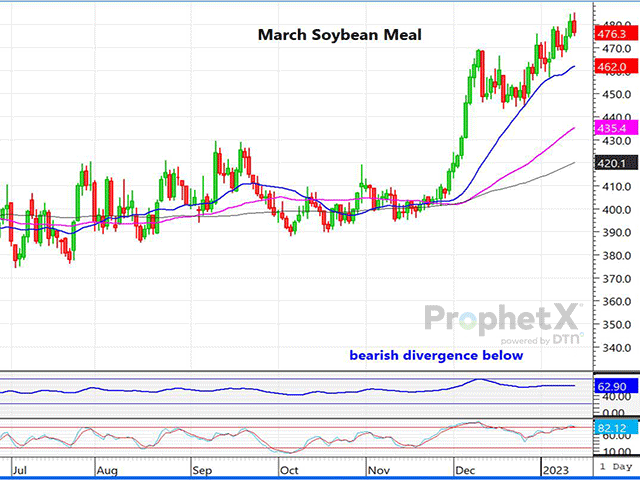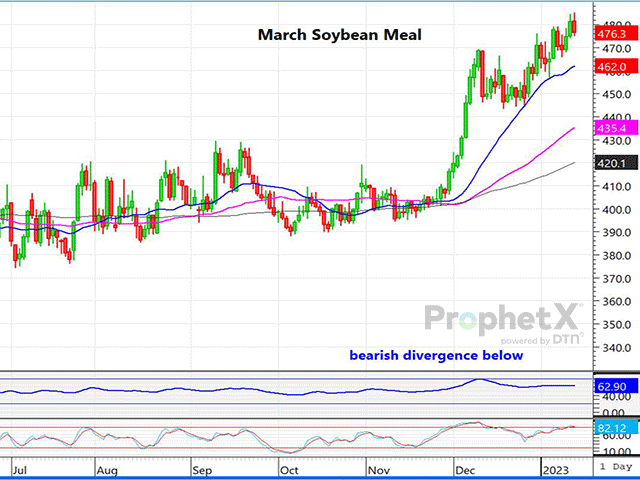Technically Speaking
Soybean Meal Showing Signs of a Tired Rally?
I have talked about this before, and I have chosen to again: The soybean meal market has been rallying in the past few months, setting new contract highs along the way, and overcoming some bearish chart signals. However, each time, it has recovered to score another new contract high, as it did again on Friday. However, after reaching that new contract high, March meal again retreated, closing the day $5 lower.
Along with the rejection of higher prices, we have a market that is approaching severely overbought and has what is called "bearish divergence" on momentum indicators, such as relative strength index and stochastics. Bearish divergence is where the market is making new highs, but momentum indicators are not doing the same. That is the case with March soybean meal. Bearish divergence will often signal a correction in the market, but does not give a timeline.
The current rally is primarily based on the premise that Argentina's worst drought in years could lead to better U.S. soybean meal export interest. That may or may not be the case, as Brazil is in the middle of harvesting what is expected to be a record-large soy crop. Brazilian soybean meal is currently offered well below that of the U.S.
P[L1] D[0x0] M[300x250] OOP[F] ADUNIT[] T[]
Adding fuel to rally has been the unrelenting fund buying, which has led to the largest net funds long on record -- estimated to be 149,000 contracts as of last Friday. The largest fund long on record is surely a warning sign in the event of some bearish news -- for instance, some better-than-expected Argentine rain.
MARCH CORN FUTURES:March corn futures last week broke out above the 50-day moving average, and even closed modestly above the 100-day moving average. The chart looks favorable and is not yet overbought. The strength comes despite the tepid export demand, with USDA dropping the export sales forecast by 150 million bushels (mb) last week. However, last week's January report found Dec.1 stocks well below trader expectations, and soon U.S, exports should become more competitive as old crop Brazil supplies are dwindling, and the U.S. is priced below Argentina. The chart looks like there is more potential upside ahead.
MARCH CHICAGO WHEAT FUTURES:Chicago March wheat futures have been beaten down in the past several months, and aside from a three-day sympathy rally last week following the bullish USDA report, which saw Dec. 1 wheat stocks fall to the lowest number in 15 years, wheat has had little to cheer about. Commodity funds have loaded the boat on a net-short position in Chicago wheat, which, as of last Tuesday, was 63,000 contracts will be fuel for a bullish correction at some point. The question is when? There are better rain chances for the arid southwestern Plains in the coming week, and Russia continues its relentless cornering of world wheat export markets. However, with the ongoing Ukraine war, and low U.S. and world stocks, being short wheat is a risky proposition. Keep an eye on this oversold market.
**
Comments above are for educational purposes and are not meant to be specific trade recommendations. The buying and selling of grain and soybean futures involve substantial risk and are not suitable for everyone.
Dana Mantini can be reached at Dana.Mantini@dtn.com
(c) Copyright 2023 DTN, LLC. All rights reserved.






Comments
To comment, please Log In or Join our Community .